Brad Paley, creator of Text Arc and many other gorgeous data visualizations popular here at if:book, has put together a fascinating lecture series running March through July in New York. The series starts next Thursday in Chelsea with renowned typographer Robert Bringhurst. From Brad:
“I’m excited to have put together something that seems tailor-made for the interests of Institute for the Future of the Book participants and on-lookers.”
Information Esthetics: Lecture Series One starts March 31 in Chelsea
People who value clarity and engagement is visual displays, whether as fine art or on Wall Street, are invited to seven evenings with some of the field’s deepest thinkers and finest practitioners. The series opens with distinguished typographer Robert Bringhurst at 6:00 pm, March 31 at the Chelsea Art Museum. Fine spirits and snacks will be served. It’s free with the $3 discounted museum admission.
A little more about Information Esthetics..
Making data meaningful–this phrase could describe what dozens of professions strive for: Wall Street systems designers, fine artists, advertising creatives, computer interface researchers, and many others. Occasionally something important happens in these practices: a data representation is created that reveals the subject’s nature with such clarity and grace that it both informs and moves the viewer. We both understand and care. This is the focus of Information Esthetics.
Information Esthetics, a recently formed not-for-profit organization, has organized a lecture series dedicated to helping this happen more often.
For the full program, visit InformationEsthetics.org. Thanks, Brad! We’ll definitely be there.
Category Archives: conferences_and_excursions
institute for the future of the book field trip to the recent past
last night Printed Matter “the world’s greatest source for artists’ publications” threw open the doors to their storage space. my colleague, dan visel, and i couldn’t resist the opportunity to rummage through the bins for hidden treasures dating from the late 70s. 2 thoughts: we’re still a long way from the time when browsing an electronic archive will be anywhere near as pleasing, at least on the sensual plane; paper art may have hit it’s height in that moment with the arrival of desktop publishing and cheap xeroxing; now a lot of the energy that people were putting into the creation of paper art is likely going into e-artifacts and e-zines.
building the cathedral: collaborative authorship and the internet
The World Wide Web is, quite possibly, the most collaborative multi-cultural project in the history of mankind. Millions of people have contributed personal homepages, blogs, and other sites to the growing body of human expression available online. It is, one could say, the secular equivalent of the medieval cathedral, designed by a professional, but constructed by non-professionals, regular folk who are eager to participate in the construction of a legacy. Such is the context for projects like Wikimedia and the Semantic Web, designed by elite programmers, built by the masses.
 One of the most pressing questions with regard to collaborative authorship is, can the content be trusted? Does the anonymous group author have the same authority as the credentialed single author? Is our belief in the quality of information inextricably connected to our belief in the authority of the writer? Wikimedia (the non-profit organization that initiated Wikipedia, Wikibooks,, Wiktionary, Wikinews, Wikisource, and Wikiquote) addresses these concerns by offering a new model for collaborative authorship and peer review. Wikipedia’s anonymously published articles undergo peer review via direct peer revision. All revisions are saved and linked; user actions are logged and reversible. “This type of constant editing,” Wikimedia co-director Angela Beesley alleges, “allows you to trust the content over time.” The ambition of Wikimedia is to create a neutral territory where, through open debate, consensus can be reached on even the most contentious topics. The Wikimedia authoring system sets up a democratic forum where contributors construct their own rulespace and policies emerge from consensus-based, rather than top-down, processes. So the authority of the Wikimedia collaborative book depends, in part, on a collective self-discipline that is defined by and enforced by the group.
One of the most pressing questions with regard to collaborative authorship is, can the content be trusted? Does the anonymous group author have the same authority as the credentialed single author? Is our belief in the quality of information inextricably connected to our belief in the authority of the writer? Wikimedia (the non-profit organization that initiated Wikipedia, Wikibooks,, Wiktionary, Wikinews, Wikisource, and Wikiquote) addresses these concerns by offering a new model for collaborative authorship and peer review. Wikipedia’s anonymously published articles undergo peer review via direct peer revision. All revisions are saved and linked; user actions are logged and reversible. “This type of constant editing,” Wikimedia co-director Angela Beesley alleges, “allows you to trust the content over time.” The ambition of Wikimedia is to create a neutral territory where, through open debate, consensus can be reached on even the most contentious topics. The Wikimedia authoring system sets up a democratic forum where contributors construct their own rulespace and policies emerge from consensus-based, rather than top-down, processes. So the authority of the Wikimedia collaborative book depends, in part, on a collective self-discipline that is defined by and enforced by the group.
The collaborative authoring environment engendered by the web will make even more ambitious and far-reaching projects possible. Projects like the Semantic Web, which aims to make all content searchable by allowing users to assign semantic meaning to their work, will organize the prodigious output of collaborative networks, and could, potentially, cast the entire web as a collaboratively authored “book.”
the web in the world
In ten years, the world wide web has become an indispensable fact of life. Where do we take it next? At the conference’s closing plenary session, Peter Lunenfeld asked a similar question: “What is the next big dream that will keep us going? Are we out of ideas?” He then offered something called “urban computing” as a possible answer.
Here is my attempt (rather long, I apologize) to jump on that dream…
I live in New York, and in the past few years I’ve observed a transformation. My neighborhood coffee shop looks like an advertisement for Apple. At any given time, no less than two thirds of the customers are glued to their laptops, with mugs of coffee steaming in perilous proximity. 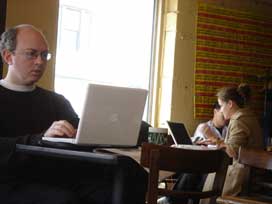 Power cords snake among the tables and plug into strips deployed around the cafe floor. Go to the counter and they’ll be happy to give you a dog-eared business card bearing the password to their wireless network. Of course, people have been toting around notebook computers since they first became available in the mid-80s, and they’ve certainly been no stranger to coffee shops. But with the introduction of Wi-Fi people are flocking in droves. Some kind of exodus has begun.
Power cords snake among the tables and plug into strips deployed around the cafe floor. Go to the counter and they’ll be happy to give you a dog-eared business card bearing the password to their wireless network. Of course, people have been toting around notebook computers since they first became available in the mid-80s, and they’ve certainly been no stranger to coffee shops. But with the introduction of Wi-Fi people are flocking in droves. Some kind of exodus has begun.
It’s a familiar sight throughout the more cosmopolitan neighborhoods of the city. Go to any Starbucks on the Upper West Side and you’re competing with half a dozen other customers for a space on their too-few powerstrips. And their Wi-Fi service isn’t even free. And come spring, I predict the same will occur in the city’s parks, especially those downtown, which are rapidly being integrated into a massive wireless infrastructure. No single entity is responsible for this, rather a lattice of different initiatives working toward a common goal: free high speed Wi-Fi coverage across Manhattan.
Mobile web and messaging technologies have already created a new breed of roving web users. Cell phones, PDAs, text messaging, Blue Tooth, RSS, podcasting (the list goes on..) have swept into our daily life like a tidal wave. More and more, we’re able to read, search, capture, edit, and send on the go, and with satellite-fed positioning technologies, we can pinpoint our location at any given time. What we have is the beginnings of a kind of “augmented reality” where information relates intimately to place, and vice versa. The world itself can now be as searchable, linkable, and informative as the web – a synthesis, or overlay, of real and virtual realities.
So the next big dream could be the evolution of the web into something more than a desktop system – into something that we can use while moving, and interact with anywhere.
collecting and archiving the future book
The collection and preservation of digital artworks has been a significant issue for museum curators for many years now. The digital book will likely present librarians with similar challenges, so it seems useful to look briefly at what curators have been grappling with.
At the Decade of Web Design Conference hosted by the Institute for Networked Cultures. Franziska Nori spoke about her experience as researcher and curator of digital culture for digitalcraft at the Museum for Applied Art in Frankfurt am Main. The project set out to document digital craft as a cultural trend. Digital crafts were defined as “digital objects from everyday life,” mostly websites. Collecting and preserving these ephemeral, ever-changing objects was difficult, at best. A choice had to be made between manual selection, or automatic harvesting. Nori and her associates chose manual selection. The advantage of manual selection was that critical faculties could be employed. The disadvantage was that subjective evaluations regarding an object’s relevance were not always accurate, and important work might be left out. If we begin to treat blogs, websites, and other electronic ephemera as cultural output worthy of preservation and study (i.e. as books), we will have to find solutions to similar problems.
The pace at which technology renews and outdates presents a further obstacle. There are, currently, two ways to approach durability of access to content. The first, is to collect and preserve hardware and software platforms, but this is extremely expensive and difficult to manage. The second solution, is to emulate the project in updated software. In some cases, the artist must write specs for the project, so it can be recreated at a later date. Both these solutions are clearly impractical for digital librarians who must manage hundreds of thousand of objects. One possible solution for libraries, is to encourage proliferation of objects. Open source technology might make it possible for institutions to share data/objects, thus creating “back-up” systems for fragile digital archives.
Nori ended her presentation with two observations. “Most societies create their identity through an awareness of their history.” This, she argues, compells us to find ways to preserve digital communications for posterity. She notes that cultural historians, artists, and researchers “are worried about a future where these artifacts will not be accessible.”
the tomorrow book
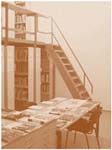 “The Jan van Eyck Academie and the Charles Nypels Foundation invite designers, book critics, book theoreticians and book makers to submit project proposals in the context of the research project ‘The tomorrow book. Navigating to, within and beyond the book’. ‘The tomorrow book’ intends to query the future of the book from a multi-disciplinary standpoint. In doing so, the following aspects will be treated: editing, typography, book design, publishing and distribution. The umbrella theme of the project is navigation towards, inside and outside of the book. Research candidates can submit project proposals for ‘The tomorrow book’ up to 15 April 2005.”
“The Jan van Eyck Academie and the Charles Nypels Foundation invite designers, book critics, book theoreticians and book makers to submit project proposals in the context of the research project ‘The tomorrow book. Navigating to, within and beyond the book’. ‘The tomorrow book’ intends to query the future of the book from a multi-disciplinary standpoint. In doing so, the following aspects will be treated: editing, typography, book design, publishing and distribution. The umbrella theme of the project is navigation towards, inside and outside of the book. Research candidates can submit project proposals for ‘The tomorrow book’ up to 15 April 2005.”
More information on “the tomorrow book” research…
the book is doomed
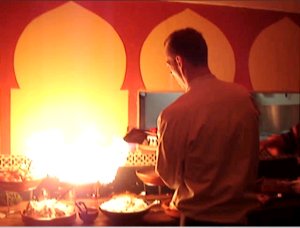 “The book is doomed.” That was Steven Pemberton‘s definitive answer to my musings about the future of the book in the digital age. It was the end of the first day of an international conference on web design, we were at the Friday night conference dinner, eating a crè me brulee that had been set ablaze just minutes before, and I don’t mean the little blue acetylene flame that puffs out after a few seconds. The chef blasted our crè me brulee for several minutes with a torch that looked like something a forest ranger would use to execute a controlled burn.
“The book is doomed.” That was Steven Pemberton‘s definitive answer to my musings about the future of the book in the digital age. It was the end of the first day of an international conference on web design, we were at the Friday night conference dinner, eating a crè me brulee that had been set ablaze just minutes before, and I don’t mean the little blue acetylene flame that puffs out after a few seconds. The chef blasted our crè me brulee for several minutes with a torch that looked like something a forest ranger would use to execute a controlled burn.
So, I’m eating my crè me brulee, trying to understand this pronouncement; when someone like Steven Pemberton says that the book, in the digital age, is doomed, you have to take it seriously. He cites The Innovator’s Dilemma, by Clayton M. Christensen. The thesis, Pemberton explains, has to do with the process of innovation and adoption. A new invention has to find a niche market that will allow it to improve and develop. Once the new invention advances enough to allow it to compete with the entrenched technology it is quickly adopted. This often radically changes an industry. Pemberton gives computer printers as an example. Anyone remember the old dot matrix printers? They had gears on the side that fit into corresponding holes in the paper. Remember how slow they were and how poor the quality was? The introduction of the laser printer made vast improvements in printer quality and as soon as printer technology improved, a revolution in desktop publishing was made possible.
The book, Pemberton contends, will experience a similar sea-change the moment screen technology improves enough to compete with the printed page.
light reading
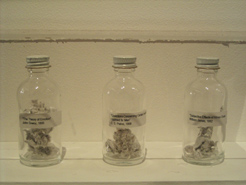 “The Book as Object and Performance exhibition (through January 22 @ Gigantic Art Space in New York, curated by Sara Reisman) presents work by over 20 artists, each using the book as a point of departure to explore the physical, sensual or conceptual dimension of reading and the written word.
“The Book as Object and Performance exhibition (through January 22 @ Gigantic Art Space in New York, curated by Sara Reisman) presents work by over 20 artists, each using the book as a point of departure to explore the physical, sensual or conceptual dimension of reading and the written word.
But despite lofty ambitions, the exhibit provides little more than light reading. Though several works are visually arresting, few do more than glide over the potentially bottomless themes at hand. Most stick to playful reorganization of materials: a pile of wooden hoops culling newspaper headlines from around the globe; a precarious tower of books with a gaping acid-chewed hole at the top; a doorway filled with crumpled sheets of paper; a dictionary with words dislocated from their definitions. A collection of small, easily forgotten pleasures.
An exception to this is a mysterious piece titled “Perseverance” by Jenny Perlin consisting of a small, worn book in a glass case, above which plays a strange film of man battling anxiety, chewing his nails to the quick. Also memorable was a one-night-only “reading” of the ten commandments by Polish-born artist Maciej Toporowicz, a piece first performed in communist Poland in 1980, and part of small program of live explorations last night, filling out the “performance” part of the equation. The gallery lights are extinguished and Toporowicz takes his place in front of an illuminated glass bowl of water, perched atop an open Bible. He places his face in the water, as though reading through the aqueous medium, and remains there long enough for the audience to start imagining.. what? That he is drowning in this sacred, much-abused text? That he is drawing impossible sustenance from its power? He begins to twitch and tremble. Finally his head rips up out of the water, gasping.
The photo above shows bottles containing philosophical texts that have been literally chewed up and spit out. Click below to see more pictures from the exhibition…
the book as object and performance – exhibit in New york
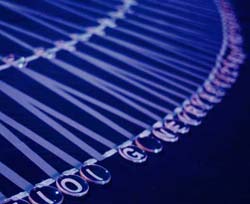
“The Book as Object and Performance is an exhibition of artworks that takes the format of the book as a point of departure to deconstruct that which is bound up in text, image and the physicality of books.”
Through January 22 @ Gigantic Art Space
*Plus: tomorrow night, in conjunction with the exhibition!
Thursday, December 16, 6-8pm: an evening of performances by AUX (Reynard Loki and Christopher Shores), Joseph A. Fish, Jesal Kapadia, Pia Lindman, and Maciej Toporowicz..
more from USC conference: useful dichotomies for reconsidering scholarship in the digital era
from Tara McPherson:
– content/context
– practice/theory (practice as research in action)
– process/product (embrace productive failure)
– open/closed (what does versioning mean?)
– dialogue/argument (new ways of marshaling evidence; what does it mean when argument shifts into dialogue?)
– pedagogy/scholarship/service (tenure system is archaic; most non-traditional modes of scholarly inquiry are considered nothing more than community service)
– many/single (how do we rethink collaboration?)
– tools/theories (blurring that boundary)
Tara McPherson is Associate Professor of Gender and Critical Studies; Chair, Division of Critical Studies, School of Cinema-Television, USC; and editor of the forthcoming Vectors, an electronic peer-reviewed journal.
